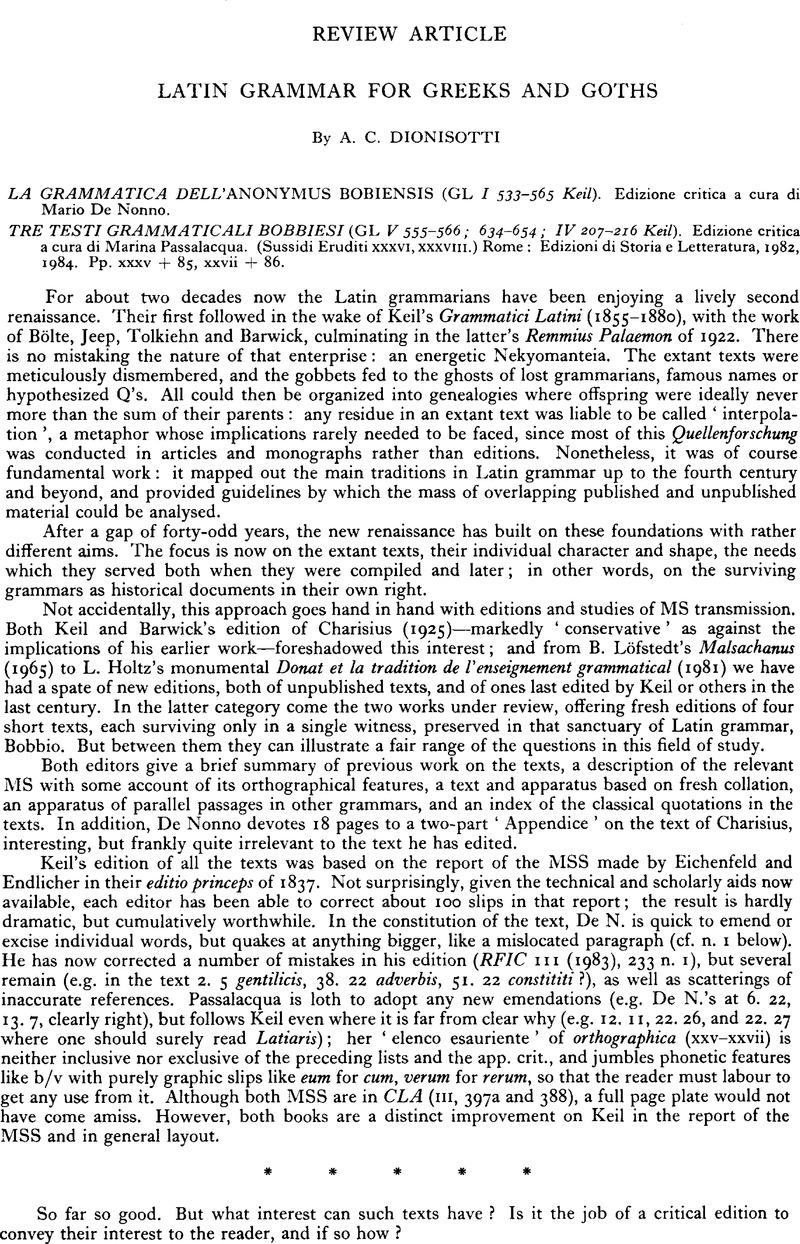Article contents
Latin Grammar for Greeks and Goths
Review products
Published online by Cambridge University Press: 24 September 2012
Abstract

- Type
- Review Article
- Information
- Copyright
- Copyright © A. C. Dionisotti 1984. Exclusive Licence to Publish: The Society for the Promotion of Roman Studies
References
1 e.g.: terminology shows that 2. 11 and 2. 19–22 belong together as an alternative to the definition of appellativa in the text; intrusions of notes or words picked out in the margin: 17. 15, 24–5, 23. 16, 50. 8–13, 51. 20, 53. 27–30; mislocations of text, perhaps supplied in the margin of the exemplar: 5. 2–9 (Keil is right, cf. Dos.); 46. 6–11 belongs at 45. 28, 46. 12–14 at 46. 1, cf. both Dos. and Char.; omissions are very minor, and some hardly count as such, e.g. 15. 28, 36. 7.
2 e.g. 61. 12 assumes we are talking of nouns in -us (a paragraph would help, as also at 62. 4, and at 63. 13, introducing a doublet of 62. 14 ff.); 73. 19 assumes we are talking of genitives.
3 For monoptoton/aptoton cf. here p. 7. 7, Cled., , GL v, 45. 30Google Scholar, Prisc., , GL 11, 184. 6Google Scholar.
4 The fact that Instituta and Appendix follow our text in B is no grounds for suspicion. For they were originally a separate volume; and even if they were bound to our texts before the de nomine was copied in, it is more likely that the scribe inserted it because he had other evidence that it was by the same author, than that he arbitrarily christened it from the context into which he put it. So part of the Appendix is also found ascribed to Probus in Montp. 306. And in general scribes are all too happy to leave grammatical works anonymous if they so find them, and even if not.
5 Neither fully nor accurately recorded in the apparatus, e.g. 27. 13–20 = 617. 11–15 with all four quotations, only one in the Char. = Diom. cited. And there are consequences for the text, e.g. the nonsense at 23. 1–3, where comparison with 615. 7–11 shows that ‘aut mox futurum’ is an interpolated gloss, and that B1's corrections in this text are worthless: ‘late’ is misplaced rather than corrupt, ‘admisit’ is true to the original, cf. ibid. 599. 19, 611. 22, 632. 32.
6 cf. 26. 24–5; perhaps not fully carried through, for the position of 45. 12–46. 25 must be due to mechanical error, but one probably related to its inconsistency with 48. 18–49. 3. possibly a belated revision of Macrobius' categories.
7 e.g. 21. 12, cf. 601. 23–7, 632. 9 app.; 36. 21–3, 54. 16.
8 ‘ipsi’ at 22. 9 may not be a corruption but the redactor's misunderstanding, if his copy of Macrobius had the same lacuna as at 631. 22.
9 cf. 19. 1 with Prisc., , GL III, 6. 25Google Scholar, and id. 11, 257. 11; Terence, as a school classic, often joins Cicero, Virgil, etc.
- 2
- Cited by


